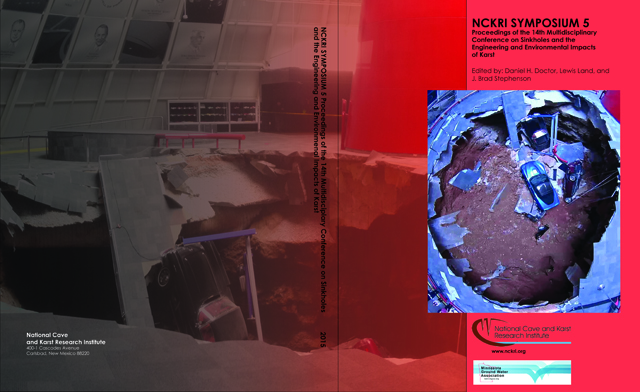Abstract
Caves provide direct access to flows through the vadose zone that recharge karst aquifers. Although many recent studies have documented the highly dynamic processes associated with vadose zone flows in karst settings, few have been conducted in mantled karst settings, such as that of southeastern Minnesota. Here we present some results of a long-term program of cave drip monitoring conducted within Mystery Cave, Minnesota. In this study, two perennial ceiling drip sites were monitored between 1997 and 2001. The sites were located about 90 m (300 ft) apart along the same cave passage approximately 18 m (60 ft) below the surface; 7 to 9 m (20 to 30 ft) of loess and 12 m (40 ft) of flat-lying carbonate bedrock strata overlie the cave. Records of drip rate, electrical conductivity, and water temperature were obtained at 15 minute intervals, and supplemented with periodic sampling for major ion chemistry and water stable isotopes. Patterns in flow and geochemistry emerged at each of the two drip sites that were repeated year after year. Although one site responded relatively quickly (within 2-7 hours) to surface recharge events while the other responded more slowly (within 2-5 days), thresholds of antecedent moisture needed to be overcome in order to produce a discharge response at both sites. The greatest amount of flow was observed at both sites during the spring snowmelt period. Rainfall events less than 10 mm (0.4 in) during the summer months generally did not produce a drip discharge response, yet rapid drip responses were observed following intense storm events after periods of prolonged rainfall. The chemical data from both sites indicate that reservoirs of vadose zone water with distinct chemical signatures mixed during recharge events, and drip chemistry returned to a baseline composition during low flow periods. A reservoir with elevated chloride and sulfate concentrations impacts the slow-response drip site with each recharge event, but does not similarly affect the fast-response drip site. Nitrate concentrations in drip waters were generally less than 4.0 mg/L as NO3- (or less than 1 mg/L as N). Nitrate was either stable or slightly increased with drip rate at the fast-response drip site; in contrast, nitrate concentrations decreased with drip rate at the slow-response drip site.
Rights Information
DOI
http://dx.doi.org/10.5038/9780991000951.1023
Included in
Hydrologic and Geochemical Dynamics of Vadose Zone Recharge in a Mantled Karst Aquifer: Results of Monitoring Drip Waters in Mystery Cave, Minnesota
Caves provide direct access to flows through the vadose zone that recharge karst aquifers. Although many recent studies have documented the highly dynamic processes associated with vadose zone flows in karst settings, few have been conducted in mantled karst settings, such as that of southeastern Minnesota. Here we present some results of a long-term program of cave drip monitoring conducted within Mystery Cave, Minnesota. In this study, two perennial ceiling drip sites were monitored between 1997 and 2001. The sites were located about 90 m (300 ft) apart along the same cave passage approximately 18 m (60 ft) below the surface; 7 to 9 m (20 to 30 ft) of loess and 12 m (40 ft) of flat-lying carbonate bedrock strata overlie the cave. Records of drip rate, electrical conductivity, and water temperature were obtained at 15 minute intervals, and supplemented with periodic sampling for major ion chemistry and water stable isotopes. Patterns in flow and geochemistry emerged at each of the two drip sites that were repeated year after year. Although one site responded relatively quickly (within 2-7 hours) to surface recharge events while the other responded more slowly (within 2-5 days), thresholds of antecedent moisture needed to be overcome in order to produce a discharge response at both sites. The greatest amount of flow was observed at both sites during the spring snowmelt period. Rainfall events less than 10 mm (0.4 in) during the summer months generally did not produce a drip discharge response, yet rapid drip responses were observed following intense storm events after periods of prolonged rainfall. The chemical data from both sites indicate that reservoirs of vadose zone water with distinct chemical signatures mixed during recharge events, and drip chemistry returned to a baseline composition during low flow periods. A reservoir with elevated chloride and sulfate concentrations impacts the slow-response drip site with each recharge event, but does not similarly affect the fast-response drip site. Nitrate concentrations in drip waters were generally less than 4.0 mg/L as NO3- (or less than 1 mg/L as N). Nitrate was either stable or slightly increased with drip rate at the fast-response drip site; in contrast, nitrate concentrations decreased with drip rate at the slow-response drip site.

